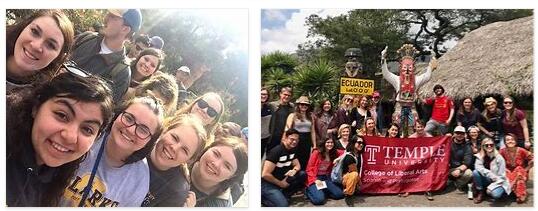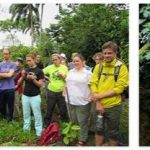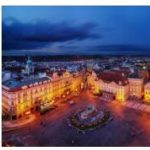Requirements
For German applicants, a secondary school qualification recognized by the Ecuadorian Ministry of Education, such as the Abitur, is the first requirement for studying in Ecuador. Depending on the university, applicants may also have to take a placement test. In this context, the mathematical, historical and linguistic knowledge of the applicants is checked.
Preparing for a degree in Ecuador
At some universities, international applicants also have to take part in a study preparation course on site. Another admission requirement for foreigners is sufficient knowledge of Spanish to be able to attend classes without any problems. Most universities offer appropriate language courses. Functional Spanish skills can be proven, for example, with a DELE certificate.
Visa and entry
As an EU citizen, you can stay in Ecuador up to 90 days a year without a visa. A passport that is valid for at least six months is sufficient for entry in such a case. As a student, you should still apply for a student visa at the Ecuadorian consulate. The so-called Visa 12-IX is obtained if you plan to study in Ecuador for three to six months.
If you exceed six months, you have to apply for the 12-V visa. In addition to the usual documents such as application and passport, a medical certificate stating that there are no infectious diseases, a police clearance certificate, proof of sufficient financial means and two passport photos must be submitted in any case.
The visa will cost around EUR 90. Is it finally arrived in Ecuador, one should have a Censo card ( Certificado de Empadronamiento ) apply. It serves as a second identification card and is issued by the migration authority. You should then ensure that the visa is registered within the first 30 days after arrival.
Ecuador Everyday Life
Everyday life in Ecuador
It is said that Ecuadorians are happy and easy going people. Perhaps, at least in the Andes mountains, the eternal spring will contribute to this? It is warm here all year round, but not too hot. The cheerful creature is usually joined by, in European eyes, perhaps a somewhat chaotic creature.
At least in the streets of cities like Quito it is loud and sometimes confusing. The buses are crowded. Punctuality? Rarely occurs. The buses have no timetable, they come or they don’t. They stop where you want – you give a show of hands. Often singers or vendors get on and try to make a little money on the bus.
Cars often do not have seatbelts. At red lights, jugglers or fire-eaters offer their skills and also try to get a little money for it. Others beg.
Punctuality is also not popular in private life. In the case of appointments or other arrangements, you don’t know exactly whether it will be kept. Serenity is required!
What you will certainly notice in Ecuador: It is a rather poor country. This is even more evident in the country than in the city – even if the streets in Quito are littered with potholes. But while 92 percent of households in the city have access to clean water, it is only 75 percent in the countryside. Many Indians live in simple mud huts. In the cities, however, you can see many beggars.
Electrical appliances such as dishwashers and washing machines that can be found in many households in Ecuador tend to have few families in Ecuador. Showers are cold and only the richer people have a telephone connection.
Eating in Ecuador
What do people in Ecuador like to eat? For many Ecuadorians, soups already taste good at breakfast. They are also sold on street stalls. Traditionally, the biggest meal is three courses at lunchtime: after a soup there is the main course, often with rice, sometimes with potatoes as a side dish to meat or fish.
At the end there is a dessert, for example Dulce de Leche (“sweets made from milk”, a cream made from milk, sugar and vanilla) or Tres Leches (“three times milk”), a cake made from three types of milk. In the evening there is usually only bread. There are also typical dishes from the coast and the Andes.
Ingredients
As a country located in Central America according to timedictionary, Ecuadorian cuisine contains ingredients such as pumpkin, corn and beans that the Indians used as staple foods centuries ago. The potato is one of them. It was already cultivated by the Inca and comes from the Andes. But the Spaniards also brought food with them that have become indispensable today, such as rice or wheat flour. Other important ingredients are plantains, yams, tomatoes, onions and avocados. On the coast people like to prepare sauces with coconut milk, in the highlands they prefer peanuts.
Guatitas
The national dish is guatitas, a stew with tripe, which is called mondongo in Venezuela or Colombia. The term tripe (Spanish: guatitas) is the name given to the cow’s stomach cut into strips (or rumen, actually a forestomach that the cow uses to ruminate). Onions, tomatoes and potatoes also come in. Guatitas are served with rice and pieces of avocado or with potatoes and peanut sauce.
Llapingacho
Llapingachos are small balls or flat cakes made from mashed potatoes (sometimes made from cassava instead of potatoes) with a cheese filling. This is then fried until crispy. There are also sausages, avocado, fried eggs and lettuce.
Guinea pig
Yes, what you probably only know as a cute pet is eaten in Ecuador with pleasure. Grilled guinea pigs are particularly popular in the Andes. This food has a centuries-old tradition in the region and is also popular in Peru and Bolivia. Incidentally, in the lowlands of the east, people also like to eat pakas and agoutis, rodents such as guinea pigs. Fried larvae are also served here!
Ceviche
As in neighboring countries, ceviche (pronounced: Ssewitsche) is popular in Ecuador, especially on the coast. The basis for this is raw fish, which is pickled in lemon juice. In Ecuador, however, there are several variants. The dish with shrimp is particularly popular. However, the prawns are cooked and served in a tomato soup. In addition to lemon juice, orange juice is also added. If ceviche is prepared with fish, it can be raw or cooked.
Ceviche de Chochos
Another type of ceviche is eaten in the mountains: it is made with the Andean lupine. This plant, called chocho in Spanish, produces seeds in legumes, similar to peas. They are made with lemons and onions, served with roasted corn and fried green bananas. So this dish is vegetarian (without meat or fish).
Humita
For humitas, you wrap a dough made from cornmeal, onions and eggs in corn leaves and then steam them. Cheese can also be included. The humitas can be prepared sweet or salty.
Cocoa and juice
A popular drink is hot cocoa. You dip a piece of cheese in it until it has melted a little and then eat it with it. If you want something cold, you like fresh fruit juices, for example made from passion fruit or oranges.






